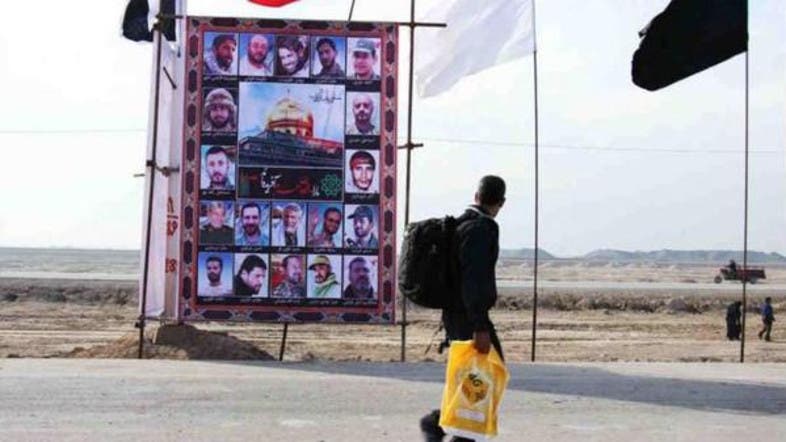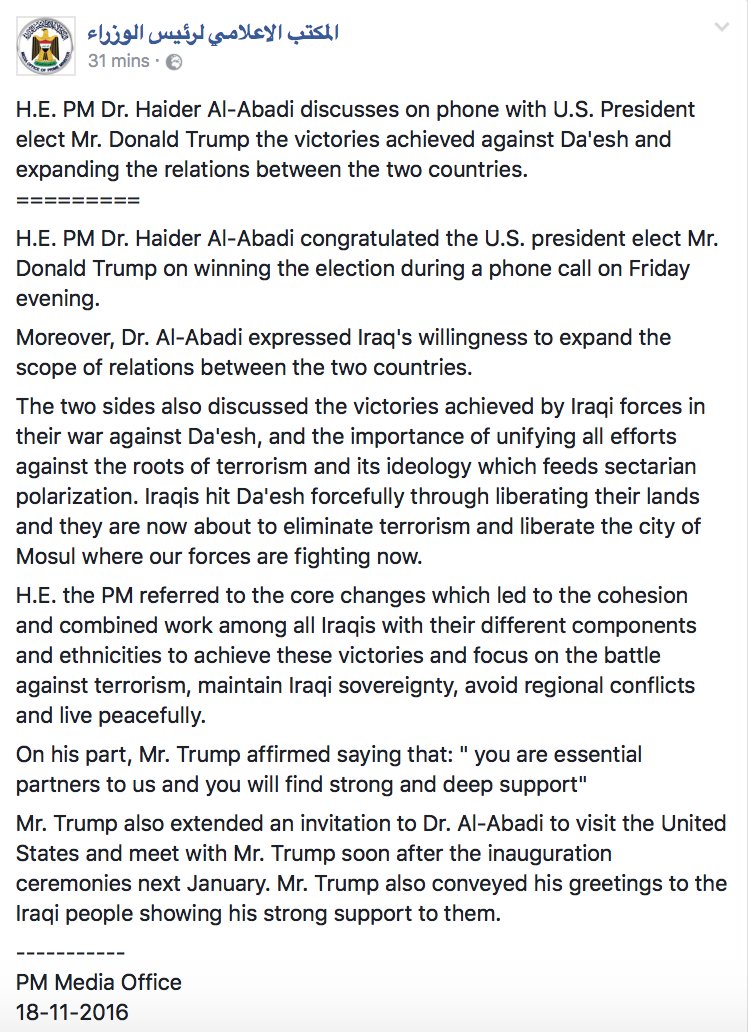Ramadan al-Saadi, Alarabiya.net Saturday, 19 November 2016
Through pictures displayed along the streets of the holy cities of Karbala and Najaf in Iraq, Tehran portrayed the number of Iranian soldiers and militia fighters killed in Syria, which has reached the milestone of 3,000. It has been an Iranian policy to exploit Shiite religious occasions to inflame sectarian sentiments when millions of devotees flock to the holy cities in Iraq. More photos here.
In Syria’s Aleppo, Shiite militias point to Iran’s unparalleled influence
BEIRUT — Syria’s government hopes a brutal siege will vanquish rebel holdouts in the city of Aleppo, a key battleground. But Syrian President Bashar al-Assad’s troops aren’t leading the charge.
That task has been taken up by thousands of Shiite militiamen from Lebanon, Iraq, Pakistan and Afghanistan who are loyal to Iran, a Shiite country and perhaps Assad’s most important ally.
For much of Syria’s civil war, these religiously motivated fighters have reinforced Syria’s badly weakened military. Now, they are playing an increasingly critical role in trying to seize opposition-held eastern Aleppo by coordinating their attacks with government forces and warplanes flown by Russia, another ally of Assad’s.
The government, backed by Russian aircraft, launched a major offensive across northern Syria last week that has brought further devastation to eastern Aleppo, Syria’s largest city before the war.
The militias appear to be forming a sophisticated ground coalition that has further bolstered Iran’s influence in Syria, alarming even officials in Assad’s government, said Phillip Smyth, an expert on Shiite militias at the Washington Institute for Near East Policy.
“They are building a force on the ground that, long after the war, will stay there and wield a strong military and ideological influence over Syria for Iran,” he said. “And there is not much Assad can do to curb the rising influence of these groups, even though Syrian officials are clearly concerned about this, because the militiamen are literally preventing the overthrow of his government.”
Analysts say Iran has long used Shiite militias in other countries to project its power. The groups include multiple factions that dominate Iraqi politics, as well as the Lebanese Hezbollah militia, which is more powerful than Lebanon’s military.
Iran and its militias have frustrated U.S. officials. While both sides find themselves aligned against the Islamic State in Iraq, they are at cross-purposes in Syria, where anti-Assad rebels receive funding and arms from Washington and its allies.
Eventually, analysts say, Iran could even find itself in direct competition with Russia for influence in Syria.
The Shiite militias’ presence in Syria also has fueled Iran’s regional and religious rivalry with Saudi Arabia, a Sunni powerhouse that backs Syria’s Sunni-led rebellion.
Still, the payoff of using militiamen could be substantial. If the Syrian government is able to seize all of Aleppo, the regional balance would tip in Iran’s favor, dealing a blow to Saudi ambitions and the rebels who stormed the city’s eastern areas in 2012, said Fawaz Gerges, professor of Middle Eastern politics at the London School of Economics.
“A defeat of the rebels in Aleppo would be a turning point in which Assad captures most of the urban centers of Syria,” he said. “It would be a setback for Saudi Arabia in its rivalry with Iran, which, as a result, would see its influence in Syria increase even more.”
The dozens of militias there have led the way in imposing a crushing blockade of the city’s opposition districts, where more than 200,000 people face worsening shortages of food and medicine. The fighters also call in air raids by Russian and government warplanes that have wrecked hospitals, residences and infrastructure in those areas.
Rebels have indiscriminately shelled government-held western Aleppo, but destruction there has not been as severe.
This month, rebel fighters in Aleppo launched a counteroffensive, but they have struggled to break the siege. Air power – especially Russia’s – has proved a formidable obstacle. The Shiite militiamen have, too, said Zakaria Malahfiji, a member of the Fastaqim rebel force, which is affiliated with the umbrella Free Syrian Army.
“They are fighting with passion, and they fight in well-coordinated attacks,” he said. “I remember one battle where these fighters just kept dying in one spot. One guy would charge, get shot and die, and then another, and then another and then another would do the same thing on the exact same spot. All of them died. They are motivated.”
The hard-line Sunnis of the Islamic State and other religious extremists have overshadowed the revolt against Assad that began peacefully in 2011 before turning into brutal war. Militants linked to al-Qaida have played a prominent role among rebel forces.
To the rebels, the Iranian-backed militiamen are extremists.
“They are spreading Iran’s influence and their extremist ideology, but our revolution is not about religion; it’s about freedom and dignity,” said Abdulmunem Zaineddin, a religious scholar involved with rebel forces in the battles in Aleppo.
The militias say their involvement in the civil war is about defending Shiite shrines in the country, as well as battling extremist Sunni groups.
“We don’t want sectarian violence. We want to protect Syria, to protect all that is sacred to everyone from terrorism, from the terrorist groups paid for by Saudi Arabia, Turkey, Qatar and the U.S.,” said Hisham Al Mossawi of Harakat al-Nujaba, a militia from Iraq whose fighters also are battling in Aleppo.
It’s unclear how many Shiite militiamen and militia factions are participating in the Aleppo battle. Hundreds and perhaps even thousands of the fighters have been killed during the war, including generals from Iran’s paramilitary Revolutionary Guard Corps.
Avi Dichter, chair of Israel’s foreign affairs and defense committee, said this month that as many as 25,000 Shiite militants are fighting in Syria. Other analysts say the number is smaller.
Israeli intelligence closely monitors the fighting in Syria and, in particular, Hezbollah’s role in the conflict. Since it fought a devastating war with Israeli forces in 2006, the Lebanese militia has become more powerful, partly because of the battlefield skills honed in Syria.
Hezbollah intervened in Syria early on in the war, helping Assad’s forces rout rebels in key western areas of the country.
“The fighting has made (Hezbollah) a better fighting force and more adept in conventional military warfare,” Dichter said.
In Aleppo, Hezbollah and Iranian Revolutionary Guards play prominent leadership roles, directing the foreign Shiite militiamen, many of whom are recruited by, and trained in, Iran.
The factions are learning to overcome issues such as linguistic differences, helping them become more adept at coordinating ground assaults, said Smyth, the analyst.
“History proves that whenever Iranians craft groups like these, such as Lebanese Hezbollah, they don’t give up arms, they don’t stand down and they don’t leave territory that they’ve taken,” he said. “They will be in Syria for years and years, and that will have consequences for everyone.”
Iraqi Shiite Militias Complicate Fight to Defeat ISIS in Mosul, Other Areas
(New York, NY) – (CEP) today released updated resources on three powerful Iraqi Shiite militias, as their involvement in the fight for the Sunni-dominated ISIS stronghold of Tal Afar, west of Mosul, is raising fears of the return of sectarian warfare to the area.
The three militias—the Badr Organization, Kata’ib Hezbollah, and Asaib Ahl al-Haq—are the most powerful among Iraq’s Popular Mobilization Forces (PMF), a government-sanctioned umbrella group composed of predominantly Shiite fighters with strong military and financial ties to Iran. In a July report, Human Rights Watch documented killings, disappearances, torture, and the destruction of homes by the groups during the fight to retake Fallujah and other Sunni-dominated areas from ISIS. The organization urged that Iraq prevent the Shiite militias from playing any role in the campaign to drive ISIS from Mosul.
The Badr Organization began in 1983 as the military wing of an Iraqi political party that sought to bring Iran’s Islamic Revolution to Iraq and fought alongside Iran during the Iran-Iraq War. The Badr Organization is run by Hadi al-Amiri, who has a history of instigating sectarian violence in Iraq. He has also been linked to a 1996 attack in Saudi Arabia that killed 19 U.S. Air Force servicemen.
Kata’ib Hezbollah (KH) is an Iranian-sponsored, anti-American Shiite militia that earned a reputation for targeting U.S. and coalition forces with roadside bombs and improvised rocket-assisted mortars. KH fought with the Assad regime in Syria at the behest of Iran’s Islamic Revolutionary Guard Corps (IRGC). KH has remained virulently anti-American, repeatedly boycotting battles against ISIS in which U.S. airpower contributes. In 2009, the U.S. Treasury Department designated KH and its leader, Jamal Jaafar Ibrahimi (a.k.a. Abu Mahdi al-Mohandes), for threatening stability in Iraq, declaring that KH and Ibrahimi “committed, directed, supported, or posed a significant risk of committing acts of violence against Coalition and Iraqi Security Forces.”
Asaib Ahl al-Haq (AAH) has claimed responsibility for more than 6,000 attacks on American and Iraqi forces. Its founder and leader, Qais al-Khazali, reportedly led the January 2007 attack in Karbala that killed five U.S. soldiers. Today, AAH continues to commit sectarian violence, carry out homophobic attacks, and threaten the “interests” of Western countries participating in strikes in Syria.



